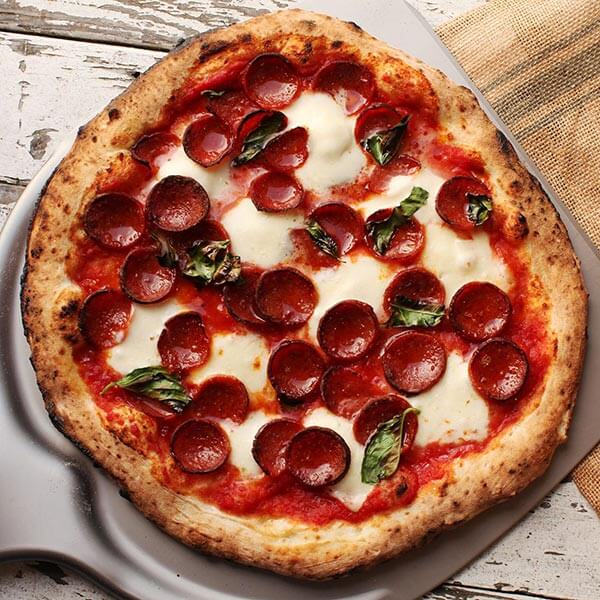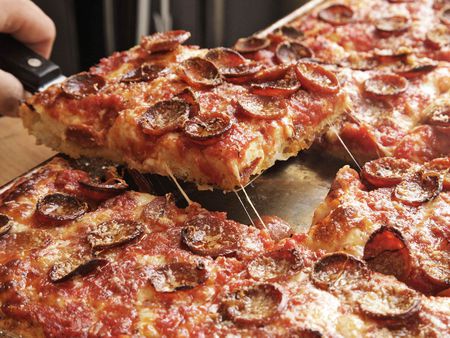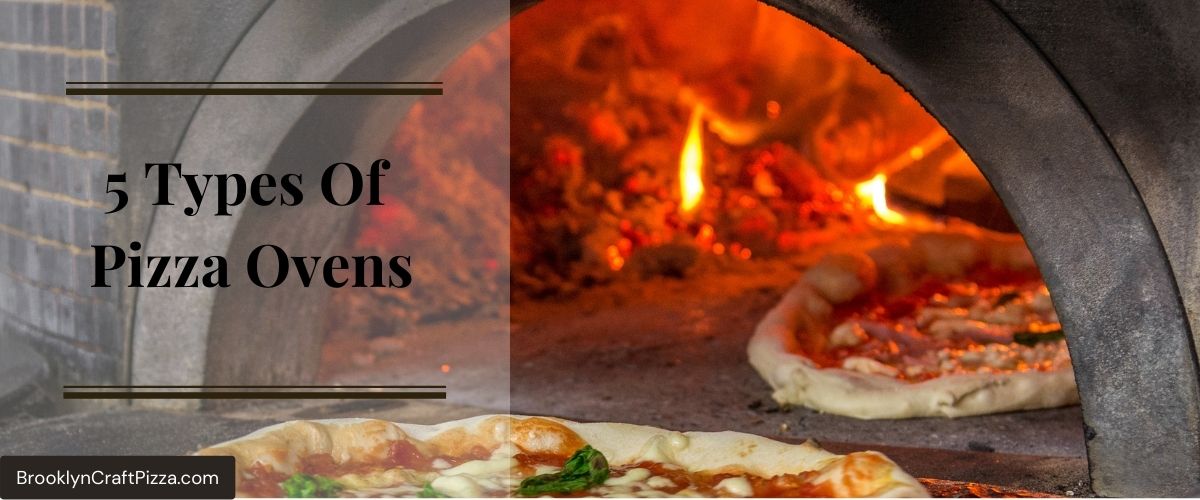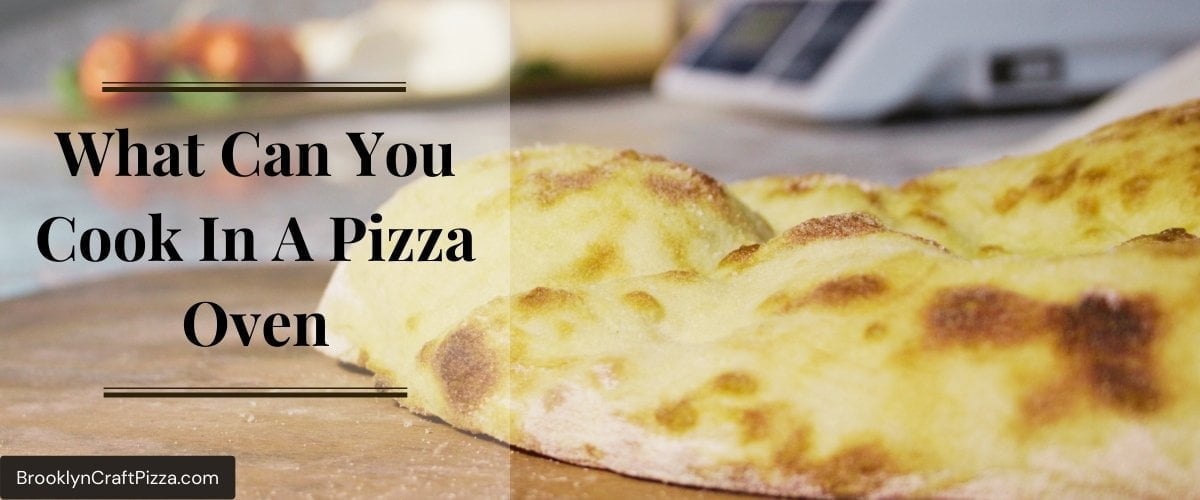Neapolitan Vs. Sicilian Pizza: All The Differences You Need To Know
There has been a longstanding debate on the merits of Neapolitan and Sicilian pizza. I’m sure you’ve heard this question before: “Neapolitan vs. Sicilian pizza, Which is better?” The answer to that question can’t be given without first understanding what makes each style of pizza so special.
In this article, we’ll discuss some key differences between these two styles and evaluate which one might be right for your taste buds.
The debate about which is the best pizza style has been going on for years. There are two main styles of pizza: Neapolitan and Sicilian. Let’s explore these two different styles to find out which one will be your favorite!
Here’s what you need to know about Neapolitan vs. Sicilian Pizza.
Neapolitan Pizza
What is Neapolitan Pizza?
Neapolitan Pizza (or pizza Napoletana) is one of the first styles of pizza. It originated in Naples, Italy, where it became very popular. This style of pizza is defined by its thin crust and simple ingredients.
History of Neapolitan Pizza
To truly understand this style of pizza, you need to take a look at its origins. Back in the 1700s, bakers in Naples would bake unleavened bread topped with oil, ingredients, and cheese for their customers. This flatbread was known as focaccia Alla Napoletana.
The traditional way to cook these pizzas was over an open flame inside a wood oven. After being cooked, toppings were added before serving.
This cooking method lent itself well to creating very thin crusts that were crispy on the outside but chewy on the inside – perfect for holding up lighter toppings.

The King of Naples took notice of this new light pizza and started serving it to his court. It quickly became popular with the people and started spreading throughout Italy.
In 1889, a pizza chef by the name of Raffaele Esposito created a pizza for Queen Margherita that was inspired by the colors of the Italian flag.
The red sauce represented the tomato sauce, the green basil represented the freshness of Italian herbs, and the white mozzarella represented the purity of milk. This pizza soon became known as pizza Margherita.
Today, Neapolitan Pizza is one of the most popular types of pizza in the world. There are strict rules that must be followed in order to call a pizza ” Neapolitan “.
These rules include using certified ingredients, making pizzas in a wood-fired oven, and using a pizza peel to place the pizzas into the oven. This style of pizza can range from very light and crispy to dense and chewy depending on how it’s made.
We will go into more detail about Neapolitan pizza so that you can easily imagine the similarities and differences between Neapolitan vs. Sicilian pizza
What does Neapolitan pizza taste like?
The dough for Neapolitan pizzas is usually made with water, yeast, salt, and flour. Once you have your basic dough recipe down the possibilities are endless!
Some common toppings are basil leaves, fresh mozzarella cheese, marinara sauce, sausage, pepperoni slices, mushrooms, bell peppers, onions, extra virgin olive oil, garlic cloves.
Other items often included in a classic Margherita pie are tomato puree or slices, fresh basil leaves, and sometimes Parmesan cheese.
Neapolitan Pizza Nutrition
One slice of Neapolitan pizza contains roughly about 350 calories. If you were to eat an entire 14″ pizza by yourself, you’d be consuming 5400 – 6600 calories which is the recommended calorie intake on a daily basis for some people!
Of course, if you can’t finish eating all of it at once, reheating the leftovers the next day will drastically reduce the amount of calories/carbs/fat in your meal.
Types Of Neapolitan Pizzas
There are 3 different types of Neapolitan Pizza:
-Margherita: This pizza is made with olive oil, fresh basil leaves, and tomatoes. It’s usually topped with mozzarella cheese.
-Marinara: This pizza is made without cheese and typically has garlic, oregano, and tomato sauce. It’s known for having a very “light” taste compared to the other styles.
-Prosciutto Crudo E Arugula: As you may have guessed from the name of this pizza it contains prosciutto crudo (thinly sliced Italian ham), arugula leaves, and Parmesan cheese.

There are many, many more variations of this style of pizza including white pizzas and others with some very unique toppings!
-The Four Seasons: This pizza has four sections – each representing a different season. The toppings include olives, prosciutto cotto (ham), mushrooms, bell peppers, and tomatoes.
-Hawaiian Pizza: This pizza is made with Canadian bacon, pineapple chunks, and mozzarella cheese.
-Quattro Formaggi: This pizza is made with 4 types of cheese – mozzarella, provolone, gorgonzola, and Parmesan.
-The White Pie: This pizza is made with Alfredo sauce (a creamy white sauce), chicken breast strips, and mozzarella cheese.
As you can see there are endless possibilities when it comes to creating your own Neapolitan pizzas at home!
Sicilian Pizza
What is Sicilian Pizza
In contrast to Neapolitan, Sicilian pizzas are usually much thicker when cooked. They also have a crunchier crust, making them easier to hold when folded in half length-wise.
In Sicily, traditional pizzas were made with a thicker crust and had more ingredients piled on top of the dough before being cooked in a wood oven.
The word sfincione refers to this type of pizza which is found in the city of Palermo.

The main difference between sfincione and “regular” Sicilian-style pizzas is that sfincione has a thinner layer of dough, a greater variety of toppings, and ricotta cheese mixed into the dough itself giving it an even creamier texture.
Some common toppings for sfincione include onions, anchovies, olives, capers, and tomatoes.
History of Sicilian Pizzas
Sicilian Pizza was developed by Italian immigrants that moved to New York City during the 20th century.
These people had an abundance of tomatoes and flour available to them, so they started making this new type of pizza with those items as the base.
The use of dough for these pizzas wasn’t introduced until later on when bakeries realized they could make extra money by selling it along with their baked goods
The first Sicilian pizzas were made in the city of Catania in the 18th century. Pizzas were cooked in a wood-fired oven and typically had a very thick dough.
The toppings for these early pizzas were usually limited to onions, anchovies, olives, and tomatoes. The dough was sometimes made with yeast or fermented dough.
What does Sicilian pizza taste like?
The dough for Sicilian pizzas is usually made with water, yeast, salt, and flour. Once you have your basic dough recipe down the possibilities are endless! Some common toppings are onions, anchovies, olives, capers, and tomatoes.
Pizza toppings for a Sicilian pizza usually consist of a mix of meats and vegetables. The most common meats used are ham, bacon, pepperoni, and salami. As for the vegetables, you’ll see a variety of bell peppers, onions, olives, and tomatoes.
Sicilian Pizza Nutrition
Just like most types of pizza, the toppings are usually what make each slice of Sicilian pizza unique in terms of its nutritional value. However, since these pizzas are thicker than other styles you can usually count on there being more bread and less toppings than other kinds.
One slice of Sicilian pizza contains about 350 – 400 calories. If you eat an entire 16″ pizza by yourself, you’ll be consuming 5100 – 6400 calories! Just like Neapolitan pizzas, reheating the leftovers will significantly reduce the amount of calories/carbs/fat in your meal.
If you’re eating just one piece of this type of pizza and leaving the rest for later, reheating it in a 160F oven overnight will reduce the amount of carbs/fat/calories in the pizza by about 40%.
Types Of Sicilian Pizzas
There are a few different types of Sicilian pizzas:
-Sicilian: This is the most basic type of Sicilian pizza and is made with tomato sauce and mozzarella cheese.
-Stuffed Sicilian: This pizza is similar to the Sicilian, but with a layer of dough that’s stuffed with cheese and other ingredients like pepperoni, sausage, or ham.
-Grandma Pizza: This pizza is also similar to the Sicilian, but has a thicker crust and more sauce.
-Quattro Formaggi: This pizza is made with four types of cheese – mozzarella, provolone, gorgonzola, and Parmesan.
-Sausage & Pepperoni: This pizza has Italian and pepperoni as its toppings.

There are many more variations of Sicilian style pizzas, but these are some of the most popular ones. Just like Neapolitan pizzas, there are many different types of Sicilian style pizzas you can make at home!
Neapolitan Vs. Sicilian Pizza, What Is Different?
Similarities
There’s a lot of great pizza in this world, but there are also two types that everybody knows about. The classic Neapolitan-style and the more exotic Sicilian variety; they’re both made with thin crusts filled to the brim with your favorite toppings at whatever temperature suits you best (hotter or colder).
They may look similar on paper – after all how could one ever decide between them?! One thing these pizzas do share though is cooked inside an oven just like any other pie out there–a key difference being its signature flavor profiles depending upon where it came from!

Differences
The classic Neapolitan is cooked at a high heat of around 800 degrees Fahrenheit in a wood-fired oven with hair thin crusts – crisp on the outside and soft in my inner cheese pockets!
Neapolitan pizzas are known for their thin crusts. This type of pizza is cooked at a high temperature in a wood-fired oven, with the heat reaching upwards of 800 degrees Fahrenheit!
Because this style of cooking uses such high heat, you can expect your Neapolitan pizza to cook quickly and become crisp on the outside while remaining soft and chewy on the inside.
Sicilian pizzas typically have thicker crusts than Neapolitan pizzas. Some varieties even contain more dough than toppings! The key to producing a great tasting Sicilian style pizza is all about using quality ingredients and proper baking procedures.
The Neapolitan and Sicilian pizzas are both made with a thin crust, they have many toppings to choose from.
The one difference between them is how these two different types of pizza cook in an oven: while the Naples’ pies spend around 10 minutes on top rack at 500 degrees Fahrenheit or higher; Sichilians require less time- only 4 -5 minutes total (with flames coming out).
Another similarity between the two pizzas is that they both receive a similar amount of heat–the Neapolitan spends around 10 minutes on top rack at 500 degrees Fahrenheit or higher, and Sichilians require less time- only 4 -5 minutes total (with flames coming out).
So, what makes these two different from each other? The way it’s baked!
Both types of pizza are cooked inside an oven just like any other pie out there–a key difference being its signature flavor profiles depending upon where it came from.
The difference in baking time is all about cooking for the right amount of time that ensures the perfect crust. The quality of your pizza depends entirely upon how you bake it; therefore it’s crucial to know what kind of oven you’re using as well as its temperature differences.
The key takeaway here is: practice makes perfect! So, if you don’t want to risk any mistakes and your family isn’t getting tired of those frozen pizzas – now would be an awesome time take advantage of great deals on ovens this Black Friday!
In a wood-fired oven, with the heat reaching upwards of 800 degrees Fahrenheit! Because this style of cooking uses such high heat, you can expect your Neapolitan pizza to cook quickly and become crisp on the outside while remaining soft and chewy on the inside.
Sicilian pizzas typically have thicker crusts than Neapolitan pizzas. Some varieties even contain more dough than toppings! The key to producing a great tasting Sicilian style pizza is all about using quality ingredients and proper baking procedures.
Summary The Similarity & Differences Between Neapolitan vs. Sicilian pizza
- Sicilian pizza is typically thicker than Neapolitan pizza
- Sicilian pizza uses a different kind of dough it’s often fermented or has yeast in it
- Sicilian pizza usually has more tomato sauce than Neapolitan pizza
- Neapolitan pizza is cooked in a woodfired oven at 800 degrees Fahrenheit for 10 minutes while Sicilian pizza may have a longer cooking time at 500 degrees Fahrenheit for 5 to 10 minutes.
- Neapolitan pizza is considered to be the original pizza style while Sicilian pizza is a newer variation of the style.
Neapolitan vs. Sicilian pizza: Which Is The Best For You?
Which Is Better? Sicilian or Neapolitan? Pros & Cons
There is no clear answer when it comes to deciding Neapolitan vs. Sicilian pizza, which type of pizza is the best. Both Sicilian and Neapolitan pizzas have their own unique qualities and flavors that make them stand out from one another.
It all comes down to personal preference. Whether you enjoy Neapolitan or Sicilian pizzas, both types of pizza have their own unique qualities and flavors! But if you’d like a more in-depth explanation, check out the table below:
Pros:
- Better for making at home because it’s easy to prepare a thicker crust this way.
- Oven baking is simple enough that even amateur cooks can do it with little trouble.
Cons:
- The dough takes longer to rise when compared to Neapolitan style pizza doughs.
- Since there is less surface area on each slice, you end up with smaller portions per piece. This can make it harder to fill yourself up if you have a hearty appetite!
Neapolitan Pizza
Pros:
- Quick to prepare since the dough takes less time to rise. This makes it perfect for those who want their pizzas in a hurry!
- It’s easy to cook your pizza at home using a traditional oven. This makes it easier to produce restaurant-quality dishes without having experience as a professional chef.
Cons:
- You end up with larger portions per piece, but they are thinner and crispier than Sicilian pizzas. This means that there isn’t as much room for additional ingredients like cheese or sauce. You also risk burning your hand when eating because the crust may become too hot before the rest of the pizza is ready to eat!
So which type of pizza is better?
In my opinion, when coming to Neapolitan vs. Sicilian pizza, both of them are delicious and have their own unique qualities that make them worth trying!
Although I love the thicker crust of a Sicilian pizza, I can’t resist those crispy, thin Neapolitan pies that look and taste amazing.
They are both wonderful in their own ways which makes them perfect for various occasions. Now it’s time to pick your side and enjoy both kinds for yourself for the best experience possible!
Whether you’re a fan of Neapolitan or Sicilian style pizzas, there’s no doubt that both types are delicious! So next time you’re feeling pizza cravings, go ahead and try out a recipe for whichever type of pizza you prefer – you won’t be disappointed!
What type of pizza is suitable for people on a diet?
Neapolitan vs. Sicilian pizza, both Neapolitan and Sicilian pizzas are great options for those on a diet, as both styles are relatively low in calories.
However, Neapolitan pizzas tend to be the lower calorie option of the two, with an average of around 350 calories per serving.
Sicilian pizzas tend to have more dough and toppings, which can lead to higher calorie counts – typically around 500 calories per serving.
So if you’re looking for a lighter pizza option, Neapolitan is the way to go! But either style will still leave you feeling satisfied without breaking your diet goals.
Both Neapolitan and Sicilian pizzas are great options for those on a diet
Neapolitan pizzas tend to be the lower calorie option of the two, with an average of around 350 calories per serving
Sicilian pizzas tend to have more dough and toppings, which can lead to higher calorie counts – typically around 500 calories per serving.
So if you’re looking for a lighter pizza option, Neapolitan is the way to go!
So regardless of the style of pizza you enjoy more, there’s no denying that both Sicilian and Neapolitan pizzas will be delicious regardless of your diet goals.
Kids love them too so why not grab a couple of slices next time your family is craving some homemade Italian cuisine?
In addition, you may be interested in How many calories a slice of pizza have, which helps you control your body.
Making Your Own Neapolitan Pizza
If you’re interested in trying out a Neapolitan pizza recipe at home, there are plenty of great options online.
The dough is simple to prepare, and all you need is an oven and a pizza stone to cook it on. Once the dough has had time to rise, you can top it with your favorite ingredients – I recommend using fresh mozzarella cheese and basil leaves for the perfect Neapolitan flavor.
Then bake it in your oven until the crust is golden brown and crispy, and enjoy!
Here are detailed step-by-step instructions on how to make your own Neapolitan pizza:
Ingredients and Their Quantities:
- 1 ½ teaspoons of active dry yeast (or 2 teaspoons of instant yeast)
- 3 cups of all-purpose flour
- 2 tablespoons of extra virgin olive oil
- 1/2 teaspoon salt
Quantities can be adjusted based on personal preference. For example, if you want a thicker crust then add more flour or less salt.
If you’d prefer a thinner, crunchier crust then add less flour or increase the salt content in the dough. Proportions listed above will yield a medium sized pizza with a thin, crispy crust.
Additions such as spices can be added to enhance the flavor for those who wish to experiment and try something new!
Preparations:
- Begin by heating 1 ½ cups of water until warm (this should take around 1 minute in a microwave)
- Add the yeast and sugar to the water and stir until dissolved
- Let the mixture stand for 5 minutes until bubbles start to form on top, which indicates that the yeast is active
- Pour 1 cup of flour into a large mixing bowl and keep the remaining 3 cups nearby. Slowly pour the yeast mixture overtop, followed by salt and olive oil. Stir with a wooden spoon or spatula until dough begins to come together and pull away from the side of the bowl.
- Start gradually adding flour one cup at a time while continuing to stir with your wooden spoon. Be careful not to add too much flour as the dough will become harder to stir and work with
- Once all of the flour has been incorporated, dump the mixture out onto a lightly floured surface and knead for another 5 minutes until the dough is smooth and elastic.
- Cover with a damp cloth or paper towel and let rest for 30 minutes; this allows time for the yeast to activate and rise.
- Remove from the bowl once doubled in size (should take about 30 minutes).
- Lightly grease your pizza stone with olive oil before placing your ball of dough on top.
Pizza Toppings:
Most people like their Neapolitan pizzas topped simply with sauce, fresh mozzarella cheese, basil leaves, and maybe a little Parmesan cheese.
However, you can add any of your favorite toppings to the pizza – the sky’s the limit! So get creative and have some fun with it.
Instructions:
1) Preheat oven to 500 degrees Fahrenheit
2) Stretch dough out into a round shape on your greased pizza stone
3) Spread sauce evenly overtop (use about 1/2 cup for a medium sized pizza)
4) Sprinkle with mozzarella cheese and top with basil leaves
5) Bake in preheated oven for 8-10 minutes until crust is golden brown and cheese is bubbly
6) Remove from oven and enjoy!
Your homemade Neapolitan pizza is now ready to enjoy! Buon appetito!
Some tips on making your own Neapolitan pizza
If you’ve never made Neapolitan pizzas before, they can be pretty easy to prepare. Here are some tips that will help your pizza come out perfectly if you’re new to cooking this style of pizza!
1) Make sure your oven is set on at least 500°F so the crust cooks completely without the cheese burning or boiling over.
You can also put your oven’s broiler on for a couple of minutes to brown up the cheese topping – just watch it carefully so it doesn’t burn!
2) Let your dough sit for about 20 minutes after its first rise in order to bring it back down to room temperature. After this, give the dough another hour or two of rising time until it has roughly doubled in size.
When placing the dough on the pizza stone or baking sheet, make sure to stretch it out into a circular shape – don’t make it too thin though, or it will be difficult to hold all of the toppings without them falling off!
3) Add your tomato sauce and favorite toppings sparingly. Too much sauce or topping can cause the pizza to become soggy, so go light and add more as needed.
4) Bake your pizza for no more than 10 minutes, so the crust doesn’t get too browned or crispy. Neapolitan pizzas should be soft and chewy, not crunchy!
With these tips in mind, you’ll be able to make some delicious Neapolitan pizzas right in your own kitchen – and you don’t even need a pizza oven!
Making Your Own Sicilian Pizza
If you’re looking to make a Sicilian pizza instead of a Neapolitan, the dough recipe is basically the same but there are a few key differences in the way it’s prepared and baked. For starters, Sicilian pizzas use a lot more dough – usually enough for 2 pizza pies.
The dough is also rolled out thicker than for a Neapolitan, and is typically cooked in a deep-dish pizza pan.
Finally, Sicilian pizzas are usually topped with lots of different meats and vegetables, whereas Neapolitan pizzas are typically kept simple with just sauce, cheese, and basil leaves.
Here is an easy recipe for making your own Sicilian pizza at home.
Ingredients:
- 1 (1/2) cups warm water
- 2 tablespoons olive oil
- 1 teaspoon sugar
- 1 (.25 ounce) package active dry yeast
- 3 cups all-purpose flour
- 1 teaspoon salt
Sauce and toppings:
- 1 (15 ounces) can tomato sauce
- 1/4 cup grated Parmesan cheese
- 1/4 cup chopped fresh parsley
- 1/4 cup chopped fresh basil
- 1/4 cup chopped fresh oregano
- (Optional) 1/2 pound Italian sausage, casing removed
- (Optional) 1/2 pound pepperoni slices
Instructions:
1. In a large bowl, combine the water, olive oil, and sugar together.
2. Stir in the yeast until dissolved.
3. Add 1 cup of flour into the bowl, then stir to combine with the liquid ingredients.
4. Slowly add in 3 more cups of flour while stirring to form a thick dough mixture that pulls away from the sides of the bowl as you stir it together (you may need to use your hands).
5. Once you have added all 3 cups of flour, turn dough out onto a lightly floured surface and knead for 5 minutes or until dough is smooth and no longer sticky to touch. Form dough into ball shape once finished kneading it on the floured surface.
6. Place dough back into the large bowl that you mixed it in earlier, then brush the top of the dough with some olive oil. Cover bowl with a kitchen towel and set bowl in a warm place to rise for about 1-2 hours or until dough has doubled in size.
7. Preheat oven on high broil setting.
8. Once dough has doubled in size, roll it out onto a lightly floured surface and use your hands to press it into a deep-dish pizza pan (or 2 round pizza pans).
9. Spread tomato sauce evenly over the dough, then sprinkle Parmesan cheese, parsley, basil, oregano, sausage (if using), and pepperoniif using) over the top of the sauce.
10. Place pan on top of the bottom rack in your oven, then broil for 9-11 minutes or until the dough has cooked underneath and cheese is browned on top. 11. Remove pizza from oven, let it cool slightly before serving, slice into pieces & enjoy!
Some tips on making your own Sicilian pizza
Here are some tips on making a great Sicilian pizza, which is often prepared in the more traditional style of cooking.
1) Use a deep-dish pizza pan for making the dough, which will give it more of a traditional “Sicilian” shape.
2) Roll the dough out to be a bit thicker than you would for a Neapolitan – about 1/2 inch thick.
3) Assemble your toppings on the pizza before cooking – this will help them cook evenly and not become too dry or burnt.
4) Cook the pizza at a high broil setting in your oven for 9-11 minutes, until cheese is browned and bubbly.
5) Let the pizza cool slightly before serving, then slice into pieces and enjoy!
Now that you know how to make Sicilian pizza at home, what are you waiting for? Get out there and try some of these scrumptious recipes today!
And next time someone says “Pizza Hut!” you’ll be able to say “Sure – but can they do Neapolitan or Sicilian?” with a smile on your face 🙂
FAQs about Neapolitan vs. Sicilian pizza
What makes Neapolitan pizza different?
Neapolitan pizzas are usually smaller in size, which is why they’re sometimes referred to as “personal-sized” pizzas.
The dough used for them is typically thinner and more supple than a Sicilian pizza’s dough would be, making it a little harder to hold toppings on top of them without the crust breaking or becoming soggy.
Neapolitan pizzas have a brighter sauce flavor and feature more base ingredients, such as fresh basil leaves and garlic, while being topped with more cheese than their Sicilian counterparts.
What makes Sicilian pizza different?
Sicilian pizzas are larger in size than Neapolitan pizzas and their dough is thicker and less supple than Neapolitan dough.
This makes it harder to fold the dough over when assembling the toppings, so Sicilian pizzas usually have a more layered look with all of the ingredients piled on top.
The sauce for a Sicilian pizza is also richer and heartier, often containing beef or pork along with the tomato puree or paste, which gives it a meatier taste than Neapolitan pizza sauce. Sicilian pizzas also feature less cheese overall than Neapolitan-style pizzas do, because of their thicker crusts.
What is the difference between Neapolitan vs. Sicilian pizza and Italian pizza?
Neapolitan pizzas are typically smaller in size than Sicilian ones, which are usually thicker due to their dough being less supple. Italian pizzas can be either thicker or thinner though depending on the style of dough they were made with!
There are several different styles of dough that Italian pizzas are made from – including the most popular type, which is marinara sauce with fresh basil leaves being used as a topping.
Finally, Neapolitan pizzas use thinner crusts but have more toppings overall whereas Sicilian-style pies have thicker crusts and feature less cheese overall.
Why is Italian pizza so good?
Italian pizzas tend to be made from quality ingredients that you can really taste – especially if they’re made from authentic Neapolitan or Sicilian recipes!
The dough for these pizzas is typically hand-kneaded, which gives it a more textured and flavorful crust. And finally, the sauce ingredients are usually simple but fresh, like crushed tomatoes or tomato paste, so that the flavor of the pizza shines through.
Is Neapolitan pizza crispy?
Yes! Because Neapolitan pizzas are fried in a wood fire oven, they can be made crispy and chewy at the same time.
That’s because the high temperatures of the oven will bake the dough on one side and fry it on the other – so your pizza always comes out golden brown and delicious every time.
What makes Neapolitan pizza better than Sicilian ones?
Neapolitan-style pizzas tend to be crispier than Sicilian types because of their thinner crusts, which also means that you can fit more toppings! They’re often cooked for shorter periods of time as well, so if you like really soft dough with all of your cheese melted and gooey this is definitely the way to go.
The sauce for a Neapolitan pizza also has a brighter flavor and is made with more fresh ingredients like garlic and basil leaves, while Sicilian pizzas have a richer, heartier taste thanks to their meatier sauce.
Finally, Neapolitan pizzas feature more cheese overall than Sicilian ones do – so if you’re a fan of cheesy pies, this is the style for you!
Final thoughts on Neapolitan vs. Sicilian pizza
We’ve talked about the difference between Neapolitan vs. Sicilian pizza.
Neapolitan Pizza: These pizzas are thin with soft crusts, but still have crispy edges when baked properly. They’re typically served with mozzarella cheese instead of ricotta or shredded
Sicilian Pizza: It’s thicker than Neapolitan and has a crunchier crust. The dough is also sweeter than Neapolitan pizza dough because it includes sugar as an ingredient in its preparation.
Is Neapolitan pizza the best type of pizza? If you ask a Sicilian, they will tell you that their dish is the best.
It doesn’t matter which type of pizza is better because there are many different kinds depending on what’s available in each region. In some parts of Italy they only eat Sicilian pizzas while other regions might not even know about Neapolitan pizzas at all!
When it comes to pizza, there are many options. When it comes to Neapolitan vs. Sicilian pizza, some people prefer Neapolitan over Sicilian while others may favor the other way around. The only opinion that matters is yours!
This blog post will compare and contrast these two different types of pizzas so that you can decide which one to order next time your craving for some delicious Italian food comes on.
If you want to make your own pie at home either style can be made by following these simple recipes for a homemade Neapolitan or Sicilian pizza dough recipe and assembling with all of your favorite toppings.
We hope that this article helped answer your question about Neapolitan vs. Sicilian Pizza! If you enjoyed it please take a moment to share it with your friends and followers. As always, thanks for reading!
Let us help you find out if your favorite restaurant serves both types so that you can enjoy either one whenever you want.




